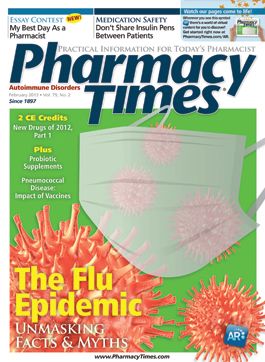Stribild-A New Approach to Pharmacoenhancement
Pharmacoenhancers can help minimize costs and maximize effectiveness.


Pharmacoenhancers can help minimize costs and maximize effectiveness.
The purposeful combination of a precipitant drug and an object drug to enhance the therapeutic activity of the object drug has been employed for many years. One of the early examples of this technique was the combination of probenecid with penicillin.1
Since that time, other drugs have been suggested as pharmacoenhancers; most recently ritonavir’s ability to inhibit cytochrome P450 (CYP) 3A4 has been used to enhance the activity of other antiviral agents. This can reduce the cost of antiviral therapy, reduce pill burden for patients, reduce the risk of subtherapeutic antiviral concentrations (development of resistance), and enhance adherence to antiviral therapy. Ritonavir has antiviral activity, but can also cause undesirable side effects, including gastrointestinal problems and lipid abnormalities. This column has previously described the benefits and potential disadvantages of using pharmacologically active drugs as pharmacoenhancers.2,3
Cobicistat: A Pharmacoenhancer Without Other Activity
The recently approved anti-HIV product Stribild contains the antiviral drugs elvitegravir, emtricitabine, and tenofovir combined with cobicistat, a pharmacoenhancer lacking antiviral activity. Cobicistat was developed to produce about the same degree of CYP3A4 inhibition as ritonavir, but without antiviral activity or problematic side effects.
Cobicistat is a substrate for CYP3A4 (CYP2D6 is a minor pathway of metabolism) and inhibits its own metabolism. Cobicistat 200 mg daily reduced the oral clearance of midazolam by 85% to 90% of that seen following ritonavir 100 mg daily, and this inhibition appeared to last for at least 16 hours after administration.4 Cobicistat is present in the formulation of Stribild to enhance elvitegravir. Cobicistat 150 mg produced approximately the same increase in elvitegravir plasma concentration as did the coadministration of ritonavir 100 mg daily.
Cobicistat also inhibits P-glycoprotein (P-gp) and CYP2D6. Thus, there are a number of potential interactions that may occur with cobicistat.
Potential Interactions with Cobicistat
Several drugs with narrow therapeutic ranges that are substrates for CYP3A4 have been listed as contraindicated in the Stribild label, including alfuzosin, ergot derivatives, cisapride, lovastatin and simvastatin, pimozide, sildenafil, and triazolam. Many of these drugs are included based upon the expected magnitude of their interaction with cobicistat. Because cobicistat has little pharmacologic activity except for enzyme inhibition, it is possible that it will find wider use as a pharmacoenhancer, particularly with other CYP3A4 substrates.
In addition to the contraindicated drugs noted above, be alert for cobicistat-induced increases in the plasma concentrations of certain CYP3A4/CYP2D6 substrates.
Cobicistat is also a modest inhibitor of CYP2D6 and, to a limited degree, P-gp. In a study with the CYP2D6 substrate, desipramine, cobicistat 150 mg daily increased desipramine’s plasma concentrations by a mean of 60%. Data for other CYP2D6 substrates are limited; however, for CYP2D6 substrates with narrow therapeutic ranges, an increase of over 50% may result in toxicity. Be particularly alert for drugs metabolized by both CYP3A4 and CYP2D6.
Cobicistat’s effect on P-gp was demonstrated by an increase in digoxin peak concentration of approximately 40% and a less than 10% increase in digoxin’s area under the concentration-time curve. It seems unlikely that typical P-gp substrates will be affected by cobicistat to the point of increased toxicity. One exception might be drugs that are eliminated by both P-gp and CYP3A4 or CYP2D6. Because cobicistat and elvitegravir are substrates of CYP3A4, inducers such as rifampin or St. John’s wort would be expected to reduce the plasma concentrations of cobicistat and elvitegravir. The plasma concentration of elvitegravir when administered with cobicistat was reduced by nearly 70% during rifampin coadministration.4 Inducers of CYP3A4 should probably be avoided in patients receiving elvitegravir.
Patients being treated for HIV are at risk for interactions with non-HIV medications. Cobicistat represents a novel compound that is effective as an antiviral pharmacoenhancer. Pending further data describing the potential magnitude of cobicistat’s effect on other drugs, the pharmacist should be alert for potential interactions in patients receiving cobicistat concurrently with CYP3A4 or CYP2D6 substrates
Drs. Horn and Hansten are both professors of pharmacy at the University of Washington School of Pharmacy. For an electronic version of this article, including references if any, visit www.hanstenandhorn.com.
References:
- Marmell M et al. Oral potassium penicillin G combined with probenecid in the treatment of gonorrhea in the male. Am J Med Sci. 1957;233:256-258.
- Horn J et al. Rx irony: drug interactions for pharmacoenhancement. Pharmacy Times. 2007;73;56.
- Horn JR, Hansten PD. Combination drugs: difficult to predict interaction outcomes. Pharmacy Times. 2007;73;42.
- Stribild clinical pharmacology and biopharmaceutics review. www.accessdata.fda.gov/drugsatfda_docs/nda/2012/203100Orig1s000ClinPharmR.pdf.
- Horn JR, Hansten PD. The Top 100 Drug Interactions: A Guide to Patient Management. Freeland, WA: 9 H&H Publications; 2013.

